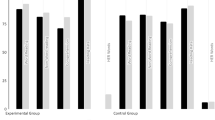Abstract
The purpose of the present study was to evaluate the effects of hand-over-hand and dot-to-dot tracing procedure to teach a 14-year-old student with autism to write his first name. The participant began the study unable to write any letters in his name. Instead, he used a name stamp when his name needed to be applied to a document in school. When asked to write a letter or word, the student would simply draw a vertical or horizontal line. A multiple baseline and reversal design was used to evaluate hand-over-hand and dot-to-dot tracing. The results indicated the participant increased his ability to write the letters in his first name “T,” “y,” and “e,” from 60% to 100 %. The study was cost effective since it required only small amounts of additional time to complete, and should be easily replicable in other classroom settings.

Similar content being viewed by others
References
Autism Society of America. (2008). About autism. Retrieved from http://www.autism-society.org.
Berger, C. (1992). Unlocking the literate minds of students with autism through technology. Writing Notebook: Creative Word Processing in the Classroom, 9(4), 5–21.
Cipani, E., & Spooner, F. (Eds.). (1994). Curricular and instructional approaches for persons with severe handicaps. Boston: Allyn & Bacon
Colasent, R., & Griffith, P. (1998). Autism and literacy: Looking into the classroom with rabbit stories. The Reading Teacher, 51, 14–20.
Duchan, J. (1998). Describing the unusual behavior of children with autism. Journal of Communication Disorders, 31, 93–112. doi:10.1016/S0021-9924(97)00084-1.
Graham, S. (1999). Handwriting and spelling instruction for students with leaning disabilities: A review. Learning Disability Quarterly, 22, 78–98. doi:10.2307/1511268.
Graham, S., Harris, K., & Fink, B. (2000). Extra handwriting instruction: Preventing writing difficulties right from the start. Teaching Exceptional Children, 33, 88–91.
Grenot-Scheyer, M., & Falvey, M. A. (1986). Functional academic skills. In M. A. Falvey (Ed.), Community based curriculum (pp. 187–215). Baltimore: Brookes.
Haring, N., Lovitt, T. C., Eaton, M., & Hansen, C. L. (1978). The Fourth r: Research in the classroom. Columbus, OH: Merrill.
Hartley, S., & Salzwedel, K. (1980). Behavioral writing for an autistic-like child. Academic Therapy, 16, 101–110.
Heward, W. L. (2009). Exceptional Children: An introduction to special education (9th ed.). Upper Saddle River, NJ: Merrill.
Hopkins, B. L., Schutte, R. C., & Garton, K. L. (1971). The effects of access to a playroom on the rate and quality of printing and writing of first and second-grade students. Journal of Applied Behavior Analysis, 4, 77–88. doi:10.1901/jaba.1971.4-77.
Houck, C. (1988). Getting them to write. Academic Therapy, 23, 489–493.
Kazdin, A. E. (1982). Single case research designs: Methods for clinical and applied settings. New York: Oxford University Press.
Koegel, R. L., & Koegel, L. K. (Eds.). (1995). Teaching children with autism: Strategies for initiating positive interactions and improving learning opportunities. Baltimore: Brookes.
Koegel, R. L., & Koegel, L. K. (2005). Pivotal response treatments for autism: Communication, social and academic development. Baltimore: Brookes.
Lovaas, I. O. (1987). Behavioral treatment and normal educational and intellectual functioning in young autistic children. Journal of Consulting and Clinical Psychology, 55, 3–9. doi:10.1037/0022-006X.55.1.3.
McLaughlin, T. F. (1981). An analysis of token reinforcement: A control group comparison with special education youth employing measures of clinical significance. Child Behavior Therapy, 3, 43–51.
McLaughlin, T. F., & Walsh, A. L. (1996). Training pre-adolescent and adolescent students with moderate mental retardation name writing skills. Journal of Developmental and Physical Disabilities, 8, 105–115. doi:10.1007/BF02578443.
McLaughlin, T. F., Mabee, S. W., Byram, B., & Reiter, S. (1987). Effects of academic positive practice and response cost on writing legibility of behaviorally disordered and learning disabled junior high school students. Journal of Child and Adolescent Psychotherapy, 4, 216–272.
McLaughlin, T. F., Williams, B. F., Williams, R. L., Peck, S. M., Derby, K. M., Bjordahl, J. M., & Weber, K. M. (1999). Behavioral training for teachers in special education: The Gonzaga University program. Behavioral Interventions, 14, 83–134. doi:10.1002/(SICI)1099-078X(199904/06)14:2<83::AID-BIN29>3.0.CO;2-6.
Markwardt, F. C. (2005). Peabody individual achievement test. Boston: Pearson AGS Globe.
Park, C., Weber, K. P., & McLaughlin, T. F. (2007). Effects of fading, modeling, prompting, and direct instruction on letter legibility for two preschool students with physical disabilities. Child & Family Behavior Therapy, 29(3), 13–21. doi:10.1300/J019v29n03_02.
Roid, G. H. (2003). Stanford–Binet Intelligence Scales (5th ed.). Itasca, IL: Riverside.
Sovik, N. (1981). An experimental study of individualized learning/instruction in copying, tracing, and handwriting based on feedback principles. Perceptual and Motor Skills, 53, 195–198.
Stokes, T., & Baer, D. M. (1977). An implicit technology of generalization. Journal of Applied Behavior Analysis, 10, 349–367. doi:10.1901/jaba.1977.10-349.
Teale, W. (1982). Toward a theory of how children learn to read and write naturally. Language Arts, 59, 555–570.
Thompson, T. (2007). Making sense of autism. Baltimore: Brookes.
Troia, G. A., & Graham, S. (2003). Effective writing instruction: What every educational consultant should know. Journal of Educational & Psychological Consultation, 14, 75–89. doi:10.1207/S1532768XJEPC1401_04.
Weiss, M. J. (2008). Skill acquisition, direct institution, and educational curricula. In J. K. Luiselli, D. C. Russo, W. R. Christian, & S. M. Wilezynski (Eds.), Effective practice for children with autism: Educational and behavioral support intervention that work (pp. 195–212). New York: Oxford University Press.
Woodcock, R. W., McGrew, K. S., & Mather, N. (2001). Woodcock Johnson Psycho-educational Battery. Reading Meadows, IL: Riverside.
Author information
Authors and Affiliations
Corresponding author
Additional information
This research was completed in partial fulfillment for the Masters of Education in Special Education at Gonzaga University. The researcher would like to thank the participant and his parents for their cooperation, support, and enthusiasm for learning. Also, the researcher would like to extend her gratitude toward the cooperating teachers for their assistance and guidance throughout this study.
Rights and permissions
About this article
Cite this article
Batchelder, A., McLaughlin, T.F., Weber, K.P. et al. The Effects of Hand-Over-Hand and a Dot-to-Dot Tracing Procedure on Teaching an Autistic Student to Write his Name. J Dev Phys Disabil 21, 131–138 (2009). https://doi.org/10.1007/s10882-009-9131-2
Published:
Issue Date:
DOI: https://doi.org/10.1007/s10882-009-9131-2




